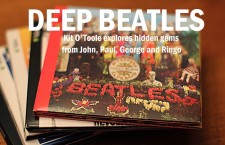Before incessant screaming and the rigors of touring took their toll, the Beatles had become one of the most polished bands on the road. That’s best heard on live performances recorded for the BBC, beginning with a March 1, 1962 appearance on Teenager’s Turn-Here We Go and ending with the special The Beatles Invite You to Take a Ticket to Ride from May 26, 1965.
The programs found the Beatles energetically performing covers and a few of their own songs, while joking around with the DJs. Yet for decades, this material was available only on bootlegs such as The Beatles at the Beeb and poor-quality recordings like Youngblood. Finally, Apple officially unveiled Live at the BBC on Nov. 30, 1994, with remastered selections from their many in-studio performances.
One of the most intriguing moments from this long-hoped-for compilation was “Honey Don’t,” which (unlike the version on 1964’s Beatles for Sale) featured John Lennon on lead vocals.
This Carl Perkins cover goes back to some of the Beatles’ 1962 shows. Back then, Lennon always sang lead. When the group entered Abbey Road Studios on Oct. 26, 1964, however, Ringo Starr was instead chosen as the new vocalist. As Starr explained in the Anthology documentary, the song appealed to him because of his deep love for country music.
“It was one of those songs that every band in Liverpool played. I used to love country music and country rock. I’d had my own show with Rory Storm, when I would do five or six numbers,” he explained. “So singing and performing wasn’t new to me; it was a case of finding vehicles for me with the Beatles. That’s why we did it on Beatles for Sale. It was comfortable. And I was finally getting one track on a record: my little featured spot.”
Starr’s performance demonstrated his charm and ability to capture the wit of the words. A year before, however, Lennon was still singing lead. They recorded a live version of “Honey Don’t” for BBC radio’s Pop Go the Beatles special, and Lennon’s gritty voice gave the song a sexier edge. His shouts seem to energize the Beatles, with George Harrison executing a solo very similar to the Perkins original. Paul McCartney plays rapid bass lines while Starr uses his uniquely heavy rock drum style.
More than anything, however, John Lennon’s rank as one of the best rock singers in music is solidified. That’s best heard on two moments that might be easily missed.
First, when he revisits the chorus beginning, “Well, I love you baby on a Saturday night”: Listen to how he lets just a bit of hoarseness enter his voice as he slightly ups the volume. It lends the line a more seductive edge, and one can picture the young Lennon standing onstage, legs akimbo, clad in all leather, making girls faint at the Star Club or Cavern Club.
Then, toward the song’s conclusion, he begins ad libbing, adding a “bop do bop” line after repeating the title. Here, john Lennon demonstrates playfulness and energy, and clearly communicates how much he loves this classic song. Lennon’s charisma shines through, and he illustrates how slight voice modulation can completely change the meaning of a track.
Ringo Starr’s later version of “Honey Don’t” has its merits, most notably how Starr manages to retain the song’s original country roots. But by then, Lennon had already transformed it on stage into the embodiment of rock: sexy and a bit dangerous.
Throughout his life, John Lennon famously hated his own singing voice. The Beatles’ Live at the BBC cover of “Honey Don’t” proves just how wrong he always was.
- The Rescued Early Paul McCartney Song That Completed ‘Beatles For Sale’ - December 4, 2024
- A Rare Beatles Cover Proves John Lennon Was Wrong About His Voice - November 26, 2024
- How John Lennon Came Roaring Back on the Beatles’ White Album - November 22, 2023


